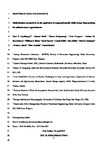Methodological perspectives on the application of compound-specific stable isotope fingerprinting for sediment source apportionment
| dc.contributor.author | Upadhayay, HR | |
| dc.contributor.author | Bodé, S | |
| dc.contributor.author | Griepentrog, M | |
| dc.contributor.author | Huygens, D | |
| dc.contributor.author | Bajracharya, RM | |
| dc.contributor.author | Blake, William | |
| dc.contributor.author | Dercon, G | |
| dc.contributor.author | Mabit, L | |
| dc.contributor.author | Gibbs, M | |
| dc.contributor.author | Semmens, BX | |
| dc.contributor.author | Stock, BC | |
| dc.contributor.author | Cornelis, W | |
| dc.contributor.author | Boeckx, P | |
| dc.date.accessioned | 2017-07-04T14:56:02Z | |
| dc.date.available | 2017-07-04T14:56:02Z | |
| dc.date.issued | 2017-06 | |
| dc.identifier.issn | 1439-0108 | |
| dc.identifier.issn | 1614-7480 | |
| dc.identifier.uri | http://hdl.handle.net/10026.1/9592 | |
| dc.description.abstract |
Purpose: Compound-specific stable isotope (CSSI) fingerprinting of sediment sources is a recently introduced tool to overcome some limitations of conventional approaches for sediment source apportionment. The technique uses the 13C CSSI signature of plant-derived fatty acids (δ13C-fatty acids) associated with soil minerals as a tracer. This paper provides methodological perspectives to advance the use of CSSI fingerprinting in combination with stable isotope mixing models (SIMMs) to apportion the relative contributions of different sediment sources (i.e. land uses) to sediments. Results and discussion: CSSI fingerprinting allows quantitative estimation of the relative contribution of sediment sources within a catchment at a spatio-temporal resolution, taking into account the following approaches. First, application of CSSI fingerprinting techniques to complex catchments presents particular challenges and calls for well-designed sampling strategies and data handling. Hereby, it is essential to balance the effort required for representative sample collection and analyses against the need to accurately quantify the variability within the system. Second, robustness of the CSSI approach depends on the specificity and conservativeness of the δ13C-FA fingerprint. Therefore, saturated long-chain (>20 carbon atoms) FAs, which are biosynthesised exclusively by higher plants and are more stable than the more commonly used short-chain FAs, should be used. Third, given that FA concentrations can vary largely between sources, concentration-dependent SIMMs that are also able to incorporate δ13C-FA variability should be standard operation procedures to correctly assess the contribution of sediment sources via SIMMs. Conclusions: This paper reflects on the use of δ13C-FAs in erosion studies and provides recommendations for its application. We strongly advise the use of saturated long-chain (>20 carbon atoms) FAs as tracers and concentration-dependent Bayesian SIMMs. We anticipate progress in CSSI sediment fingerprinting from two current developments: (i) development of hierarchical Bayesian SIMMs to better address catchment complexity and (ii) incorporation of dual isotope approaches (δ13C- and δ2H-FA) to improve estimates of sediment sources. | |
| dc.format.extent | 1537-1553 | |
| dc.language | en | |
| dc.language.iso | en | |
| dc.publisher | Springer Science and Business Media LLC | |
| dc.subject | Biotracers | |
| dc.subject | Compound-specific stable isotope (CSSI) analysis | |
| dc.subject | Erosion | |
| dc.subject | Fatty acids (FAs) | |
| dc.subject | Sediment fingerprinting | |
| dc.subject | Stable isotope mixing models (SIMMS) | |
| dc.title | Methodological perspectives on the application of compound-specific stable isotope fingerprinting for sediment source apportionment | |
| dc.type | journal-article | |
| dc.type | Review | |
| dc.type | Journal | |
| plymouth.author-url | https://www.webofscience.com/api/gateway?GWVersion=2&SrcApp=PARTNER_APP&SrcAuth=LinksAMR&KeyUT=WOS:000401436200002&DestLinkType=FullRecord&DestApp=ALL_WOS&UsrCustomerID=11bb513d99f797142bcfeffcc58ea008 | |
| plymouth.issue | 6 | |
| plymouth.volume | 17 | |
| plymouth.publication-status | Published | |
| plymouth.journal | Journal of Soils and Sediments | |
| dc.identifier.doi | 10.1007/s11368-017-1706-4 | |
| plymouth.organisational-group | /Plymouth | |
| plymouth.organisational-group | /Plymouth/Admin Group - REF | |
| plymouth.organisational-group | /Plymouth/Admin Group - REF/REF Admin Group - FoSE | |
| plymouth.organisational-group | /Plymouth/Faculty of Science and Engineering | |
| plymouth.organisational-group | /Plymouth/Faculty of Science and Engineering/School of Geography, Earth and Environmental Sciences | |
| plymouth.organisational-group | /Plymouth/REF 2021 Researchers by UoA | |
| plymouth.organisational-group | /Plymouth/REF 2021 Researchers by UoA/UoA14 Geography and Environmental Studies | |
| plymouth.organisational-group | /Plymouth/Research Groups | |
| plymouth.organisational-group | /Plymouth/Research Groups/Marine Institute | |
| plymouth.organisational-group | /Plymouth/Users by role | |
| plymouth.organisational-group | /Plymouth/Users by role/Academics | |
| plymouth.organisational-group | /Plymouth/Users by role/Researchers in ResearchFish submission | |
| dcterms.dateAccepted | 2017-03-27 | |
| dc.rights.embargodate | 2017-10-13 | |
| dc.identifier.eissn | 1614-7480 | |
| dc.rights.embargoperiod | 12 months | |
| rioxxterms.funder | European Commission | |
| rioxxterms.identifier.project | Integrating isotopic techniques with Bayesian modelling for improved assessment and management of global sedimentation problems | |
| rioxxterms.versionofrecord | 10.1007/s11368-017-1706-4 | |
| rioxxterms.licenseref.uri | http://www.rioxx.net/licenses/under-embargo-all-rights-reserved | |
| rioxxterms.licenseref.startdate | 2017-06 | |
| rioxxterms.type | Journal Article/Review | |
| plymouth.funder | Integrating isotopic techniques with Bayesian modelling for improved assessment and management of global sedimentation problems::European Commission |


